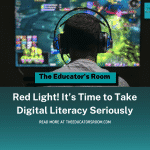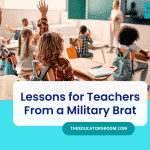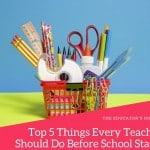Have you signed up for The Educator’s Room Daily Newsletter? Click here and support independent journalism!
In my English and writing courses, I always love to share the following Anne Lamott quote with students: “…writing needs to breathe and move.” To further expand on this quote, I explain that writing cannot be constricted in a box if it is to be truly authentic. Yet, ironically enough, for a long time, I was stopping students’ writing from breathing and moving. How? By using rubrics.
When I first started teaching, I thought it was a good idea to provide students with overly specific rubrics that they could turn to whenever they felt lost during the writing process. My rubrics used a 4-point scale: 4 equaled excellent, 3 was proficient, 2 was approaching, and 1 was unsatisfactory. (Each section was filled with specific criteria for students to meet.) It all seemed so simple to me—if a student hadn’t met the excellent score, I didn’t really have to provide much feedback. Instead, I could point to the rubric and say, “Take a look at the 4 category. That’s what you need to do.” But therein lies one of the biggest problems with rubrics.
Writing Rubrics Hinder Authentic Writing
Ultimately, rubrics shift the focus away from the writing—for both educator and student. I should’ve focused on the words students were putting down. Instead, I was preoccupied with seeing if they had met these very specific and sometimes arbitrary criteria. Stopping to really think about it, I realized that this made no sense, especially for authentic writing. During my writing process for various publications, I never stopped writing to look at a scale of any sort. But I did think about the message I was trying to send, the goals I wanted to accomplish, and the action I wanted readers to take. If I didn’t feel like I was accomplishing those things, I went back to my draft and revised it. Authentic writing—real-world writing—is never accompanied by rubrics. Sure, there are usually criteria to follow, but it’s not along a point system.
Writing Rubrics Over-Emphasize Scores
Rubrics can also cause students to reach for a perfect score and, rather paradoxically, make them forget about what truly matters. In other words, when students rely on a rubric, the goal becomes more about checking boxes and increasingly less about the writing itself. I’ve seen it time and time again in my own courses. As if completing some sort of math formula, students would try to tabulate the exact thing I was asking for. They broke their essays up into unnatural chunks to give me whatever they felt met the exact criteria they wanted to reach, nothing more and nothing less.
Writing Rubrics Promote Conformity
And that’s another major issue with rubrics: they stifle creativity. Often, educators think that rubrics are helpful because they provide criteria to meet for students to write successfully. But by providing these exact criteria, rubrics are also installing a ceiling, one that students aren’t likely to break—especially if they feel they’ve already met that “perfect mark.” This type of ceiling doesn’t exist when writing outside of the classroom space. No essays, books, or articles in the real world use rubrics. I think about authors like Sandra Cisneros or Percival Everett and imagine how their writing would never work if they had to follow a rubric. How many writers in our own classrooms are we stifling through the use of these boxed-in guidelines? Could students do more yet they don’t feel the need to push that extra mile? I think so.
Losing Rubrics, But Gaining Equity and Student Agency
Worse still, rubrics have troubling origins that have long caused inequities in schools. Educator Maja Wilson in her book, Rethinking Rubrics in Writing Assessment, outlines how rubrics were created with the specific purpose of ranking students, with students of color consistently being ranked lower than their peers. With this idea in mind, it becomes more challenging to ethically continue the use of rubrics.
Because of all the problems they engender, I no longer use rubrics in my courses. This transition was made much easier when I adopted an ungrading framework—assessment practices that decenter the use of grades and points in class. Now I want to be clear and note that the writing in my courses isn’t a free for all. Students can’t just write however they’d like. As a class, students (with my help) determine the expectations of whatever genre they are working in. From there, we produce a guide for them to follow. That might sound similar to a rubric, but there are two major differences: (1) there are no more points, percentages, or grades used, and (2) students are free to break away from the guide. They don’t feel constrained to follow it exactly because there’s no grade attached.
Since making this change, I now focus exclusively on students’ writing: on their strengths, areas for improvement, and next steps for them to take. My students and I also engage in productive, meaningful conversations about writing, and we no longer worry about checking their writing against a set of standards along a scale.
It’s Time to Reevaluate Rubrics
If you’ve ever felt the pains of student writing that was formulaic or stilted, it might be a good time to reevaluate the use of rubrics and maybe get rid of them completely. There might be some pushback—perhaps from parents, administrators, and academic institutions—because rubrics seem clear and objective. Authentic writing, and the feedback to help that writing get better, on the other hand, is messy. And messiness can seem scary. Some educators might worry about bias entering their assessment practices if they don’t use rubrics. And this concern is certainly valid, but bias cannot be completely avoided, even with rubrics. Standards, outcomes, and goals all come from someone or a group of people. The best practice is to clearly convey these biases, not to try and mask them as “objective” through the use of rubrics.
As experts in our fields—and with many of us writers ourselves—we need to communicate clearly that good writing is never formulaic. And we should be trusted as the experts to make the assessment choices in our own classrooms that will lead to authentic and genuine learning. Sometimes, students have to follow guidelines created and mandated by outside forces, usually for test-taking purposes. But this strips educators of their agency within their own classrooms. I believe that when educators have the freedom to get rid of rubrics, then students’ writing will be able to truly “breathe and move.”

Anthony Lince is a Latinx scholar, a student-centered teacher/instructor of English and first-year writing courses, and a qualitative teacher-researcher. His current research centers around equitable assessment practices. He can be found on Twitter @linceanthony and on his website at anthonylince.com.
Editor’s Note: If you enjoyed this article, please become a Patreon supporter by clicking here.






